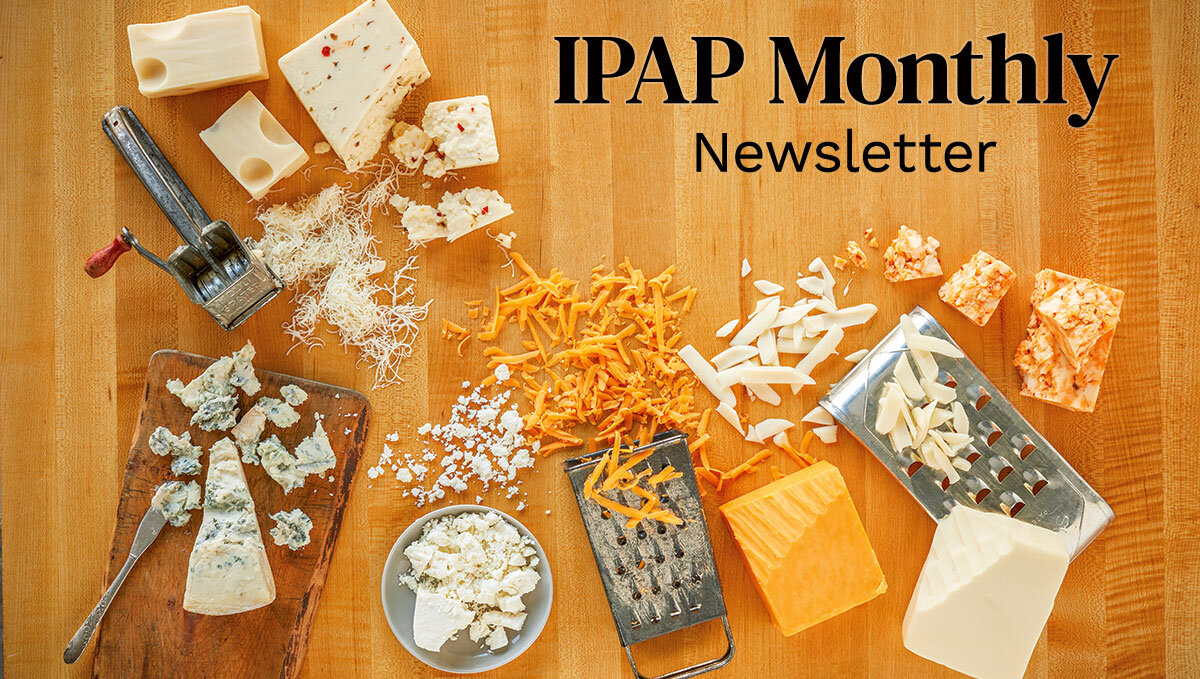

There are ways to enjoy string cheese beyond the classic method of peeling off the strands.

One way to get creative is to incorporate string cheese into a recipe. String cheese is a low-moisture mozzarella designed for snacking, but it’s a versatile ingredient that goes well in stuffed crust pizza, meatball subs, lasagna and chicken Parmesan. Beyond entrees, you can prepare plenty of tasty hors d’oeuvres with it.
Schreiber’s natural string cheese is the perfect ingredient for these recipes. It’s loaded with calcium and protein, and consumers find it highly satisfying. Panelists in a blind taste test gave Schreiber’s string cheese higher marks on key qualities, including flavor, mouthfeel, salt taste and stringability.
Schreiber’s low-moisture, part-skim mozzarella string cheeses come in original, jalapeño and smoked flavors, available to distributors in 12-, 24- and 36-count, overwrap bags and fridge packs.
Check out Schreiber’s easy string cheese snack recipes below. Whether you’re at home and looking to experiment or a restaurateur in need of appetizers for the takeout menu, now is the time to give these recipes a whirl.

Doritos Mozzarella Sticks
4 servings / 35 minutes
Ingredients
16 oz. string cheese
4 eggs (beaten)
1/4 cup milk
3 cups finely crushed Doritos
Cooking oil
Marinara sauce (optional)
Directions
- Crush Doritos in a blender until they have the consistency of breadcrumbs and pour into a dish.
- Add eggs to a separate dish with milk; whisk to combine.
- Heat a couple inches of oil in a cast iron skillet to 365°F.
- Dip string cheese into egg mixture and turn to evenly coat. Then dip in Doritos, turning to evenly coat.
- Working in batches, place breaded string cheese into the hot oil and cook for about 45 seconds. The crust should brown slightly, but the cheese should not fall apart. The cheese melts fast; do a test stick first to ensure you do not overcook them all.
- Let cool on wire rack briefly and serve with warm marinara sauce.
Pineapple Papaya and Black Bean Salsa with String Cheese
Makes 32 servings
Ingredients
4 (15-oz.) cans of black beans, drained and rinsed
1 large ripe papaya; peeled, seeded and diced
1 pineapple; peeled, cored and diced
2 large red bell pepper, small dice
4 medium jalapeño peppers
8 cups Roma tomatoes, seeded and chopped
2 bunches scallions, minced
1 cup + 2 Tbsp. fresh lime juice
½ cup + 1 Tbsp. olive oil
2 Tbsp. rice wine vinegar
1 Tbsp. sugar
2 tsp. kosher salt
¼ tsp. cayenne pepper
¼ cup fresh cilantro, chopped
16 sticks string cheese cut in half length wide and diced
Tortilla scoops
Directions
- In a bowl, combine the black beans, mango, red bell pepper, jalapeño, tomatoes and scallion.
- In a blender, plus together the lime juice, oil, vinegar, sugar, salt and cayenne. Pour the vinaigrette over the salsa and let it marinate for a couple hours in the refrigerator.
- Pull from the cooler and stir in the cilantro and cheese serve slightly chilled.
- Place in cups and serve with tortilla scoops.
Crispy Bacon-Wrapped String Cheese
6 servings / 20 minutes
Ingredients
12 string cheese sticks, unwrapped
24 strips of pre-cooked bacon
Toothpicks (optional)
Directions
- Preheat oven to 425°F.
- Line a large baking sheet/cookie sheet pan with parchment paper or foil.
- Starting at one end of each string cheese stick, wrap it completely from end-to-end with two bacon slices. If necessary, skewer each end with a toothpick.
- Place the 12 bacon-wrapped mozzarella sticks onto the lined baking sheet.
- Bake at 425°F for eight minutes or until the bacon gets crisp and cheese starts to melt; start checking after four minutes.

String Cheese Stuffed Tomatoes with Creamy Pesto Ricotta Dip
Makes 4 servings / 45 minutes
Ingredients
16 each cherry tomatoes – cut in half and seeds scooped
4 string cheese sticks
Grated Parmesan cheese
1 tsp. extra virgin olive oil
½ cup basil pesto sauce
1/3 cup ricotta cheese
1 Tbsp. milk
Salt and pepper to taste
Directions
Stuffed Tomatoes
- Preheat oven to 375°F.
- Line a large baking sheet pan/cookie sheet with parchment paper or foil.
- Place each string cheese stick on a cutting board and make three even cuts on each stick. This will give you 4 each portions per stick. After this process, you will have 16 each cheese portions.
- Place 16 half cherry tomatoes (seeds removed) on the baking sheet evenly. Portion each cheese into the tomato half, brush with oil, then coat lightly with Parmesan cheese. Season with salt and pepper if needed.
- Bake for 20-25 minutes.
Dipping Sauce
- Drain the oil from prepared pesto sauce, then transfer pesto to a medium mixing bowl.
- Add ricotta cheese and milk folding them together; season with salt and pepper.

You may have heard of the U.S. Department of Agriculture’s new $19 billion relief program, which will provide direct aid to agricultural producers and compensate food distributors for oversupply. How exactly will it work?
Most of the funding from the Coronavirus Food Assistance Program (CFAP), $16 billion, will be directed toward farmers and ranchers whose prices and market supply chains were disrupted by the COVID-19 crisis. About $9.6 billion of these direct payments will go to livestock farmers ($2.9 billion of that to dairy farmers). The remainder will go to crop growers.
Applicants will be eligible for compensation of 85% of their price losses sustained between Jan. 1 and April 15, up to $125,000 per commodity and $250,000 per tax ID. CFAP payments will be sent out in May and June.
Dairy farms can expect on average $80,000 in direct payments per farm after factoring in the largest farms with 500-plus cows – about 10% of farms – that would likely receive the maximum compensation, according to The Dairy Market Analyst.
“[I]f USDA is right in its cost estimates, we believe there is enough money to bridge dairy farmers through this restaurant-closure crisis,” The Dairy Market Analyst said of the direct payments.
In addition, $3 billion in CFAP funding will be allocated toward the government purchase of fresh dairy, meat, produce and crops from distributors and wholesalers. This product will then be distributed to food banks, nonprofits and religious organizations to help feed their community members in need. Each month the USDA will purchase $100 million per month in fruits and vegetables, $100 million in dairy products, and $100 million in meat.
Distributors can learn how to participate by contacting David Tuckwiller, Director of Commodity Procurement for the USDA, at David.Tuckwiller@usda.gov.
Beyond the CFAP, the USDA also has up to $873 million available in Section 32 funding to purchase agricultural product. The Families First Coronavirus Response Act (FFCRA) and the Coronavirus Aid, Relief, and Economic Security Act (CARES Act) allow for the additional purchase of at least $600 million in food.
The Dairy Market Analyst said of the federal government’s ag purchases: “[S]o long as restaurants are closed, these government purchases will help – but not resolve – the oversupply problem. Milk will continue to be dumped until restaurants reopen and/or producers cut back milk supplies” because domestic demand for dairy is down by as much as 20%.
Due to dining site closures in the food service industry, farmers experienced a plummet in demand for their product and cannot sell their excess output. Without markets for their product, farmers have resorted to dumping milk and plowing ripe vegetables back into the soil.
Small businesses that are facing challenges paying their employees such as suppliers and distributors are eligible for a second round of loans from the Small Business Administration’s Paycheck Protection Program. Congress made $310 billion in additional PPP aid available after the federal government ran out of the initial $350 billion. The program resumed accepting applications this week.

Are you a master of all things cheese and dairy?
Test your knowledge here. Answers appear below the Dairy Dive.
1. If you boil milk to pasteurize it, how long must the milk be heated at 212°F to ensure product safety?
A) One minute
B) 15 seconds
C) 0.01 second
2. Cheddar cheese is named after what?
A) A Roman emperor
B) An English village
C) A medieval Welsh pub
3. In 2013, Takeru Kobayashi of competitive eating fame consumed what in 20 seconds?
A) A gallon of milk
B) A 10-inch cheese pizza
C) A 2-pound tub of yogurt
4. Whole milk contains at least what percentage of milk fat by weight?
A) 4.75%
B) 4%
C) 3.25%
5. Prepared by washing the rind with beer, the French cheese Vieux Boulogne was awarded what distinction by scientists in 2004?
A) The most intoxicating cheese
B) The smelliest cheese
C) The highest-calorie cheese

Recent headlines about cheese, milk and dairy from around the web.
- Meat shortage looms as coronavirus shuts packing plants, leaving farmers with tough choices (Market Watch)
- Why dairy farmers across America are dumping their milk (CNN)
- Fact check: Farmers are dumping milk because of change in demand, bottling limitations (USA Today)
- The industry says we have enough food. Here’s why some store shelves are empty anyway. (The Washington Post)
- Coronavirus shutdown sends milk prices spiraling (Fox Business)
- Farming’s COVID Crisis: Specialty Cheese Sales, Milk Prices Plummet (Vermont Public Radio)
- Wisconsin dairy co-op to donate cheese to Midwest food banks (KMSP)
- How Safe Is It To Eat Takeout? (NPR)
- This cheese shop lost 90% of its business overnight. Now what? (Los Angeles Times)
- A Wisconsin creamery is providing free milk using a ‘kindness cooler’ (CNN)
- Milk pioneers: East African herders consumed milk 5,000 years ago (The Source at Washington University in St. Louis)
- The Reason Americans Buy Refrigerated Milk and Europeans Don’t (Mental Floss)
Quiz Time answers
1. If you boil milk to pasteurize it, how long must the milk be heated at 212°F to ensure product safety?
C) 0.01 second
2. Cheddar cheese is named after what?
B) An English village
3. In 2013, Takeru Kobayashi of competitive eating fame consumed what in 20 seconds?
A) A gallon of milk
4. Whole milk contains at least what percentage of milk fat by weight?
C) 3.25%
5. Prepared by washing the rind with beer, the French cheese Vieux Boulogne was awarded what distinction by scientists in 2004?
B) The smelliest cheese
